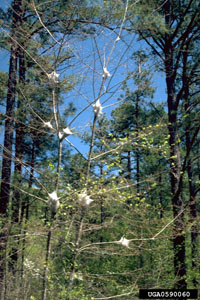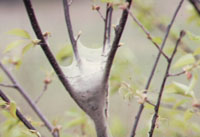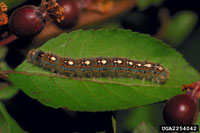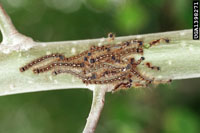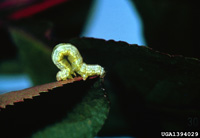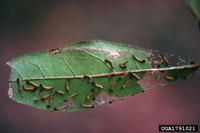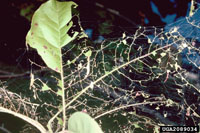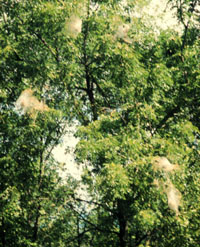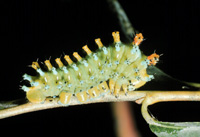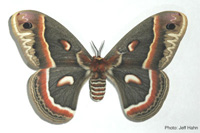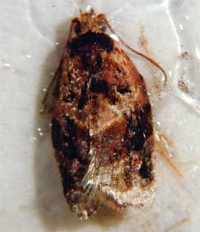Extension > Garden > Diagnose a problem > What's wrong with my plant? > Deciduous Trees > Crab Apple > Holes in leaves or parts of leaves missing
Crab Apple > Leaves > Holes in leaves or parts of leaves missing
1 of 9
Eastern Tent Caterpillar
Malacosoma americanum
- Larvae feed on leaves, sometimes defoliating trees
- They make a web or “tent” in the fork of the branches
- Larvae are hairy with blue, black, and orange markings, and a white stripe down the back, almost 2 inches when full grown
- Present during May and June
- More information on Eastern Tent Caterpillar
2 of 9
Forest Tent Caterpillar
Malacosoma disstria
- Chews entire sections of leaves, often leaving some major veins; defoliation can be severe
- Hairs along sides of body, blue and black with characteristic footprint shaped white markings on top of body, almost 2 inches long when fully grown
- Occurs in May and June
- More information on Forest Tent Caterpillar
3 of 9
Cankerworms
Paleacrita vernata and Alsophila pometaria
- Chews smalls holes between veins at first, later chewing leaf tissue except for major veins, and eventually chewing all of leaves except midvein
- Defoliation typically light to moderate, although it can potentially be severe
- Smooth-bodied, light green to brown, 1 1/3 inch long when fully grown; moves in characteristic looping motion
- Occurs late April/early May until June
- More information on Cankerworms
4 of 9
Redhumped Caterpillar
Schizura concinna
- Larva will eat entire leaf, leaving only the midvein
- Red head and a wavy black, yellow, and white striped body with a red projection (hump) on the thorax behind the head, 1 1/3 inch long when fully grown
- Occurs in August and September
- More information on Redhumped caterpillar
5 of 9
Yellownecked caterpillar
Datana minnistra
- Young larvae feed in groups and skeletonize leaves by eating the leaf tissue and leaving the veins.
- As larvae mature, they become solitary feeders and eventually eat the entire leaf.
- Larvae are active from late July through early September.
- They have black heads with striped body covered with fine white hairs and a bright yellow spot behind the head.
- More information on Yellownecked caterpillar
6 of 9
Fall Webworm
Hyphantria cunea
- Produces silken webbing that covers the ends of branches
- Chews entire sections of leaves, leaving major veins
- Yellowish or greenish with long, fine white hairs with two rows of black spots down its back
- Occurs from late July through September
- More information on Fall webworm
7 of 9
Cecropia
Hyalophora cecropia
- Chews entire sections of leaves; defoliation typically is minor
- Light green body with double row of reddish orange knobs on thorax behind head; also series of smaller yellow and blue knobs on abdomen; grows up to 4 inches long
- Becomes a large, attractive moth
- Occurs in August and September
- More information on Cecropia
8 of 9
Obliquebanded Leafroller
Choristoneura rosaceana
- Early season larvae feed on the undersurface of a leaf along the midrib or other large vein
- Early season larvae feed inside bud clusters and developing fruit, resulting in fruit drop or corky scars on the fruit
- Late season larvae can scar the fruit
- Larvae are yellow-green and 1” in length when mature
- Adult moth is reddish-brown with brown bands on the wings
- More information on Obliquebanded Leafroller
9 of 9
Redbanded Leafroller
Argyrotaenia velutinana
- Larvae skeletonize leaves from the underside, folding and webbing the leaves together
- Fruit injury is usually shallow with ragged edges and thick, corky tissue over the damaged area
- Larvae are green with a green head, and reach about ½" at maturity. Larvae are yellow-green and 1” in length when mature.
- Larvae are present early May – June
- Adults have distinct red-brown bands on the forewings that form a V-shape when at rest, and are about ¼" in length
- More information on Redbanded Leafroller



